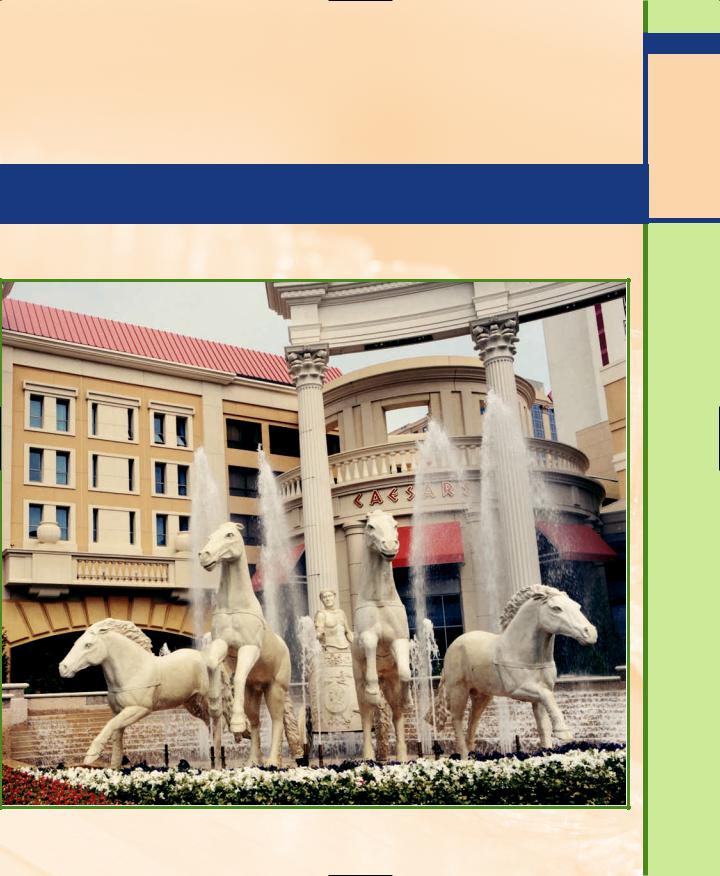
- •CONTENTS
- •PREFACE
- •Content—Benefits for Students
- •Content—Benefits for Instructors
- •Features of the Book for Students and Instructors
- •Supplementary Materials
- •Acknowledgments
- •What Is Hospitality Management?
- •The Manager’s Role in the Hospitality Industry
- •Why Study in a Hospitality Management Program?
- •Planning a Career
- •Employment as an Important Part of Your Education
- •Getting a Job
- •Employment at Graduation
- •The Outlook for Hospitality
- •Summary
- •Managing Change
- •Demand
- •Supply
- •Workforce Diversity
- •The Impact of Labor Scarcity
- •Summary
- •The Varied Field of Food Service
- •The Restaurant Business
- •The Dining Market and the Eating Market
- •Contemporary Popular-Priced Restaurants
- •Restaurants as Part of a Larger Business
- •Summary
- •Restaurant Operations
- •Making a Profit in Food Service Operations
- •Life in the Restaurant Business
- •Summary
- •Chain Restaurant Systems
- •Independent Restaurants
- •Franchised Restaurants
- •Summary
- •Competitive Conditions in Food Service
- •The Marketing Mix
- •Competition with Other Industries
- •Summary
- •Self-Operated Facilities
- •Managed-Services Companies
- •Business and Industry Food Service
- •College and University Food Service
- •Health Care Food Service
- •School and Community Food Service
- •Other Segments
- •Vending
- •Summary
- •Consumer Concerns
- •Food Service and the Environment
- •Technology
- •Summary
- •The Evolution of Lodging
- •Classifications of Hotel Properties
- •Types of Travelers
- •Anticipating Guest Needs in Providing Hospitality Service
- •Service, Service, Service
- •Summary
- •Major Functional Departments
- •The Rooms Side of the House
- •Hotel Food and Beverage Operations
- •Staff and Support Departments
- •Income and Expense Patterns and Control
- •Entry Ports and Careers
- •Summary
- •The Economics of the Hotel Business
- •Dimensions of the Hotel Investment Decision
- •Summary
- •The Conditions of Competition
- •The Marketing Mix in Lodging
- •Product in a Segmented Market
- •Price and Pricing Tactics
- •Place—and Places
- •Promotion: Marketing Communication
- •Summary
- •The Importance of Tourism
- •Travel Trends
- •The Economic Significance of Tourism
- •The United States as an International Tourist Attraction
- •Businesses Serving the Traveler
- •Noneconomic Effects of Tourism
- •Summary
- •Motives and Destinations
- •Mass-Market Tourism
- •Planned Play Environments
- •Casinos and Gaming
- •Urban Entertainment Centers
- •Temporary Attractions: Fairs and Festivals
- •Natural Environments
- •On a Lighter Note. . .
- •Summary
- •Management and Supervision
- •The Economizing Society
- •The Managerial Revolution
- •Management: A Dynamic Force in a Changing Industry
- •What Is Management?
- •Summary
- •Why Study Planning?
- •Planning in Organizations
- •Goal Setting
- •Planning in Operations
- •The Individual Worker as Planner
- •Long-Range Planning Tools
- •Summary
- •Authority: The Cement of Organizations
- •Departmentalization
- •Line and Staff
- •Issues in Organizing
- •Summary
- •Issues in Human-Resources Management
- •Fitting People to Jobs
- •Recruiting
- •Selection and Employment
- •Training
- •Retaining Employees
- •Staff Planning
- •Summary
- •The Importance of Control
- •Control and the “Cybernetic Loop”
- •Tools for Control
- •Summary
- •Leadership as Viewed by Social Scientists
- •Why People Follow
- •Leadership Theories
- •Communication
- •The Elements of Leading and Directing
- •Developing Your Own Leadership Style
- •Summary
- •A Study of Service
- •Rendering Personal Service
- •Managing the Service Transaction
- •How Companies Organize for Service
- •Summary
- •INDEX

Summary 369
determining marketing strategies. The asset manager, on the other hand, acts as the “eyes and ears” of the owner. In bridging the gap between the owner and the management company, the asset manager delivers regular reports to the owner. Specifically, the asset manager would be involved with the management company regarding the budget, reviewing the franchise contract, inspecting the property and franchise requirements, and analyzing cash flow. The asset manager can also benefit the management company by helping with the communication process, helping evaluate the management company, and pointing out to the owner when the management company is doing a good job. It is estimated that more than half of upscale hotels and resorts in the United States currently use some form of asset management. This figure is double that of five years ago. Although the use of asset management companies has been stimulated by a challenging economy, it is thought that their use will continue to escalate even in better economic times.48
ENTREPRENEURIAL OPPORTUNITIES
We should pause here to note the significance of the management company’s function for those who want to have ownership interest in a hotel. Management companies serve a need for mortgage holders and developers that can also be filled by individuals. Those individuals who, through education and experience, prepare themselves to manage a hotel can regard a time of economic reverses for the industry as a time of opportunity for themselves. In particular, with locally financed (i.e., mortgaged) properties that get into trouble, there is a real opportunity from time to time to secure an ownership position in return for assuming an existing mortgage. This kind of opportunity is more likely to occur with older properties, and so the importance of a good food background—in order to merchandise the property—is clear.
Summary
We have repeatedly made the point in this chapter that lodging is capital-inten- sive and cyclical. Because of long lead times, supply often continues to grow even after demand has stopped growing or begun to decrease. As a result, in the 11
years ending in 1993, the lodging industry lost $33 billion while construction continued throughout the period. In 1997, however, hotel profits were once again at a peak.
Securitization is selling an ownership or a debt instrument (such as a bond) in a property through the public security markets. Major developments have included the widening of lodging’s access to debt through CMBSs, to equity through IPOs and secondary offerings, and to both equity and debt through REITs. An additional form of

370Chapter 11 Forces Shaping the Hotel Business
financing has involved the public funding through a special tax. The impact of securitization has been to enable a considerable boom in hotel building. Although securitization brings advantages in the availability of capital, it also has the inherent risks associated with a falling stock market.
The hotel investment decision has three dimensions: financial, real estate, and operating. The large amount of debt associated with hotel construction gives leverage, and in the international market, changing currency values can also provide financial advantages. Low interest rates are especially advantageous to leveraged deals. Hotel real estate can provide an inflation hedge, and the speed with which hotel rates can be raised provides flexibility in rentals rates few other forms of real estate offer. Realestate development also offers profits to development companies, including hotel companies such as Marriott, which are active developers. A final means of profiting from a hotel is by operating it profitably, but this is not always the largest source of profit.
The tendency toward overbuilding in a cyclical industry is sometimes exaggerated by the segmentation strategies of major hotel companies. Segmentation can lead to a multibrand hotel company seeking to build one of each of its brands in a market. In some cases, the company may feel that being represented in a major market is more important than the short-run profit potential. Building multiple brands can also lead to problems of encroachment where the same reservation network is divided between two or more properties, and in many cases, multiple properties with the same brand in a market can reduce the advantage of a franchise. Management companies have grown up to serve nonoperator owners. In difficult economic times, these companies’ services are especially in demand as lenders become “involuntary owners.” These same difficult times, however, often offer those with operating know-how major entrepreneurial opportunities.
Key Words and Concepts
Capital intensive |
Gap financing |
Revenue per available |
Initial public offerings (IPOs) |
rooms (RevPAR) |
C corps |
Securitization |
Inflation hedge |
Commercial mortgage- |
Leverage |
backed security (CMBs) |
Management contract |
Real-estate investment |
Product segments |
trusts (REITs) |
Encroachment |
Conduit lenders |
Management company |
Mezzanine financing |
Asset managers |

Summary 371
Review Questions
1.How does the hotel business react to the business cycle? Explain why hotel building continues after demand turns down.
2.What does securitization mean? How is it affecting the hotel business?
3.What have been the major effects of securitization on competitive conditions in lodging?
4.What do the acronyms CMBS, REIT, C corp, and IPO stand for? To what does each of them refer?
5.What is mezzanine financing and what are some of its advantages?
6.What are the hazards of public ownership?
7.What is RevPAR and what can positively or negatively impact it?
8.What are the main elements of a hotel investment decision?
9.Has segmentation contributed to encroachment? What are the effects of encroachment?
10.Why did hotel management companies come into existence?
11.What is the importance of asset management to lodging owners?
Internet Exercises
1.Site name: Hotel Online
URL: www.hotel-online.com
Background information: Hotel Online is the hospitality industry’s online meeting
place, providing the latest and most relevant news, trends, discussion forums, employment opportunities, classified advertising, and product pricing available anywhere.
Site name: Lodging Econometrics
URL: lodging-econometrics.com
Background information: Lodging Econometrics is a recognized authority on all hotel real estate including the Development Pipeline and the Sale and Transfer of Lodging Real Estate nationwide. They also compile and maintain the Industry’s Census of Open and Operating Hotels including the Names of Owners and Management for more than 60,000 hotels in the United States and Canada.
Exercises:
a.Find and discuss at least two trends that are occurring in the hotel industry as defined by the consultants on this Web site.

372Chapter 11 Forces Shaping the Hotel Business
b.Based on the news articles from Hotel Online, along with your current readings in the newspaper, textbooks, and so on, discuss a trend you believe is impacting on the hotel industry and indicate why you think it is important.
2.Site name: Starwood Hotels & Resorts Worldwide, Inc.
URL: www.starwood.com
Background information: Starwood Hotels & Resorts Worldwide, Inc. is one of the
leading hotel and leisure companies in the world with approximately 850 properties in more than 95 countries and 145,000 employees at its owned and managed properties. Starwood Hotels is a fully integrated owner, operator, and franchisor of hotels and resorts.
Site name: Host Hotels and Resorts
URL: www.hosthotels.com
Background information: The vision of Host Hotels and Resorts is to be the premier lodging real estate company. Their focus is the acquisition of high quality lodging assets in prime urban and resort locations which have the potential for significant capital appreciation.
Felcor Lodging Trust
URL: www.felcor.com/
Background information: FelCor is one of the nation’s largest hotel real estate investment trusts and the owner of the largest number of upscale, all-suite hotels in the nation. FelCor’s consolidated portfolio is comprised of 92 hotels, located in 26 states and Canada.
Exercises:
a.Browse through the Web sites for the three REITs. What are the similarities and differences among them?
b.Who is the target market for each REIT?
c.What hotels and resorts are in the portfolio for each REIT?
d.Which of the above REITs is/are considered a “paper clip REIT”? How does it differ from a standard REIT?
3.Site name: American Hospitality Management
URL: www.american-hospitality.com
Background information: American Hospitality Management Company provides ho-
tel, motel and resort management, consulting services, oversight and asset management, receivership services, and technical and preopening services in all areas of the hospitality industry.
Site name: American Property Management Corp. (APMC)
URL: www.americanpropertymanagementcorp.com
Background information: APMC is an opportunistic-focused lodging company, based in San Diego, California. Ranked by HotelBusiness magazine as the seventeenth

Summary 373
largest hotel owner in the United States, APMC is a growing leader in the hospitality industry. The company’s 36 hotels and resorts are located from coast to coast.
4.Site name: Kevin Regan’s Testimony before the Committee on Homeland Security
and Governmental Affairs
URL: www.ahla.com/pdf/111605Regan.pdf
Background information: Testimony of Kevin T. Regan, Regional Vice President of Operations, Southeastern United States and Caribbean, Starwood Hotels & Resorts Worldwide, Inc., before the Committee on Homeland Security and Governmental Affairs United States Senate Hearing November 16, 2005 “Hurricane Katrina: What Can Government Learn from the Private Sector’s Response?”
Exercises:
Read the entire transcript of Mr. Regan’s testimony. Mr. Regan emphasizes throughout his presentation that the keys to successful crisis management are planning, leadership, teamwork, and communication.
a.Describe how these four components were evident throughout the description of how Starwood managed the crisis caused by the storm.
b.What lessons can be learned by hotel managers from his testimony?
c.Lead a class discussion on the importance of training staff for crisis situations whether they are the result of a severe storm, earthquake, terrorist activity, fire, and so forth.
Notes
1.The research on the hotel construction pipeline was conducted by Smith Travel Research and was reported in Hotel & Motel Management (Mark V. Lomanno, “Likelihood of Hotel Openings Related to Construction Cycle,” August 2003, p. 18).
2.Lodging Econometric, “LE Revises Supply Side Downward for ’06 and ’07 and Identifies Seven Trend Setting Markets to Monitor for ’08 and Beyond,” October 20, 2006, http://www.lodgingintelligence.com/PR/3Q06IndPress.htm.
3.PKF Hospitality Research, “Trends in the Hotel Industry,” 2003.
4.Smith Travel Research, “2002 HOST Study Findings,” www.smithtravelresearch.com.
5.PKF Hospitality Research, “Trends in the Hotel Industry—Where is the risk?,” 2006.
6.Ed Watkins, “Leaven Your Caution with Optimism,” Lodging Hospitality, July 1, 2003, p. 2).
7.PKF Hospitality Research, Trends, 2006.
8.PKF Hospitality Research, Trends, 2003.
9.PKF Hospitality Research, Trends, 2006.
10.bid.
11.Ibid.
12.Ibid.
13.Ibid.
14.Ibid.

374Chapter 11 Forces Shaping the Hotel Business
15.AH&LA Knowledge Base, “London tops European Hotel Revenue Survey/The Bench and KPMG Report,” January 18, 2007, http://ahlaradio.hsyndicate.com/news/154000320/ 4029978.html.
16.Little, Rebecca, “Private Matters—Private equity firms have become big-time players in the lodging industry. How did they become a driving force in hospitality?” Lodging archives, http://www.lodgingmagazine.com/index.cfm?fm=Article.Detail&aid=116.
17.AH&LA Knowledge Base, “Lodging Econometrics Completes Development Pipelines and Three-Year Supply Growth Forecasts for 21 Asian Countries.” October 12, 2006. http:// alharadio.hsyndicate.com/news/4029159.html.
18.Little, Rebecca, “Private Matters.”
19.The phrase “securitization of the hotel industry” is used by Patrick Ford in his article “Flood Tide,” Lodging magazine, May 1997, pp. 56–61. This section draws extensively on his work.
20.Steven Shundich, “The Art of the Deal,” Hotels, September 1997, p. 44.
21.Little, Rebecca, “Private Matters.”
22.Steven Shundich, “The Art of the Deal.”
23.The original use of the word mezzanine was to designate the floor between the lobby floor and the first floor in a building.
24.Mark Cahill, “Lending a Hand,” Hotels, May 1997, p. 62.
25.Mark Cahill, “Buy, Sell, or Refinance?” Lodging magazine archives, March 2003, www.lodgingmagazine.com/articles_view.asp?id559.
26.Patel, Kison and Robin Trehan, “Real Estate Investment Trusts (REIT) within the Hospitailty Industry,” Lodging magazine archives, http://ahlaradio.hysyndicate.com/news/ 4027198.html.
27.Ibid.
28.Ibid.
29.The term C corp is also derived from the classification of these corporations under Subchapter C of the IRS tax code. See Hotels, September 1997, p. 43.
30.Host Marriott Corp.: Several Hotels May Be Sold over Next Six to Nine Months,” The Wall Street Journal, October 20, 2003, p. 1; “Marriott Eyes High-End Hotels,” Real Estate Alert, August 20, 2003, p. 3.
31.Hayward, P., A. Taulane, and R. Little, “Lodging Innovators of 2006—Development, Chris Nassetta,” Lodging archives, http://www.lodgingmagazine.com/index.cfm?fm=Article. Detail&aid1=26.
32.Mark Cahill, “Buy, Sell or Refinance?” Lodging magazine archives, March 2003.
33.Russell Shaw, “Public-Funding Issue Stirs Strong Emotions,” Hotel & Motel Management, August 2003, p. 3.
34.The information is taken from “Timeline of Events—1997,” which was issued by Starwood Hotels & Resorts and Starwood Trust (n.d.). The final purchase price for Sheraton is taken from the companies’ press release of February 24, 1998. The months cited in the text are those of the announcement of the “definitive agreement” and not the closing date of the purchases.
35.Westchester County Business Journal, “Starwood Celebrates Fifth Anniversary of ITT and Westin Acquisitions,” March 31, 2003, p. S2.

Summary 375
36.Ryan Chittum, “InterContinental to Buy Brand,” Atlanta Journal Constitution, October 29, 2003, p. D2.
37.AH&LA Knowledge Base. “Cendant Corporation Completes Spin-offs of Realogy Corporation and Wyndham Worldwide Corporation.” August 1, 2006, http://alharadio.hsyndicate. com/news/4028335.html.
38.“Starbucks: Making Values Pay,” excerpt from Howard Schultz and Dori Jones Yang, Pour Your Heart Into It (New York: Hyperion, 1997); reprinted in Fortune, September 29, 1997, pp. 268–69.
39.Patrick Ford, “Flood Tide,” Lodging magazine, May 1997, p. 56.
40.Avner Arbel and Robert H. Woods, “Debt Hitchhiking: How Hotels Found Low Cost Capital,” Cornell Hotel and Restaurant Administration Quarterly, November 1990, pp. 98–104.
41.Peggy Berg, president, Highland Investment Advisors Group, remarks made during a workshop, “The Franchise Impact Issue: The Value of Flag Conversion,” Hospitality Industry Investment Conference, New York, June 7, 1994.
42.Michael Levin, remarks made during a workshop, “The Value of Branding,” Hospitality Industry Investment Conference, New York, June 7, 1994.
43.James J. Eyester, The Negotiation and Administration of Hotel Management Contracts, quoted in Robert M. James, “Management Companies,” Lodging magazine, June 1985, p. 105.
44.Daniel R. Lee, Lodging (New York: Drexel Burnham Lambert, 1984), p. 23.
45.Robert M. James, “Management Companies,” Lodging magazine, June 1985, p. 105.
46.Megan Rowe, “Inhospitable Hotel Management Contracts?” National Real Estate Investor, September 2003, p. 16.
47.Gordon Platt, “Hotel Outsourcing Helps Close the Financing Gap,” Global Finance, June 2003, p. 37.
48.Patricia Alisau, “Third-Party Managers Work with Asset Managers to Achieve Profitable Goals,” Hotel & Motel Management, June 16, 2003, p. 25.

The Hospitality Industry
(Courtesy of Caesars Atlantic City.)

C HCAHPATPETRE RT WOENLEV E
CompetitionTheHospitalityin the
LodgingIn ustry BusinessandYou
The Purpose of this Chapter
n this chapter, we will be concerned with competition in lodging. As we did when we considered
Ithe food service business, we will use the marketing mix as a framework for the analysis of competition. First, however, we must consider the somewhat special conditions in lodging under which this competition takes place. Then it will be necessary to describe the way in which the marketing mix is applied to lodging. Finally, we will use this perspective to consider the competitive practices of the
industry.
THIS CHAPTER SHOULD HELP YOU
1.Identify the five conditions of competition in lodging, and explain their effects on the hotel business.
2.Explain how the four Ps of the marketing mix are applied in lodging competition.
3.Describe the upstairs-downstairs segmentation in the lodging industry and how it meets the differing needs of customers.
4.Describe and provide examples of how hotels differentiate themselves through the variety and mix they provide in food service options and other services and amenities.
5.List the strengths and weaknesses of the use of yield management in the hotel business.
6.Describe the effects on lodging of travel intermediaries and distribution channels.
7.Describe the impact of the Internet on the hotel industry.
8.Explain how partnerships and frequent-guest programs operate and why they are important to marketing the lodging industry.
